 home coil info products ordering
home coil info products ordering
Loohan Communications Office
Orgone Technical Bulletin # 31
started April, 2008
Big Rock Units
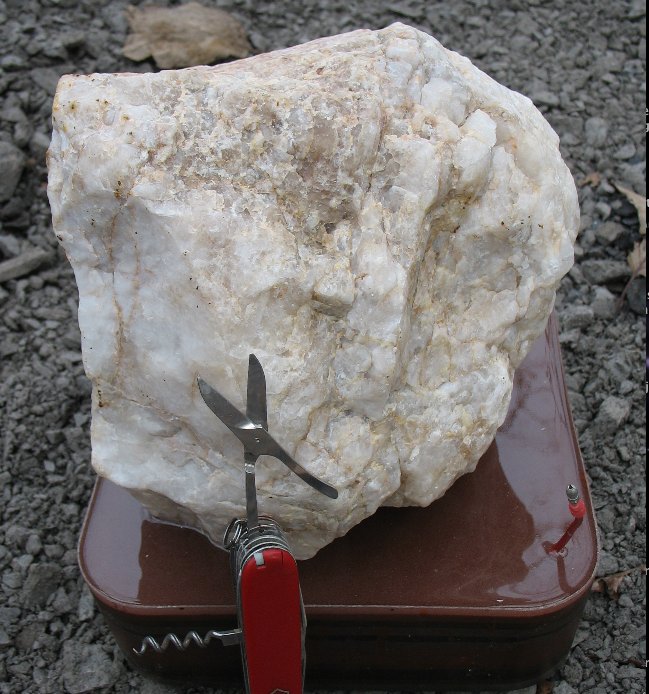
I don't know what else to call them. This OTB is about using large, usually free or cheap, rocks as the dominant component, usually with relatively little resin. This makes economic sense if you have a source of powerful rocks that don't cost you much money.
I live in a country where resin is relatively cheap, but have compassion for those who have to pay a small fortune for it.
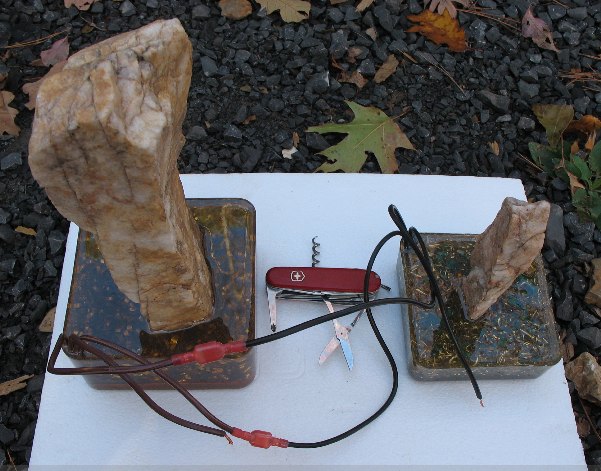

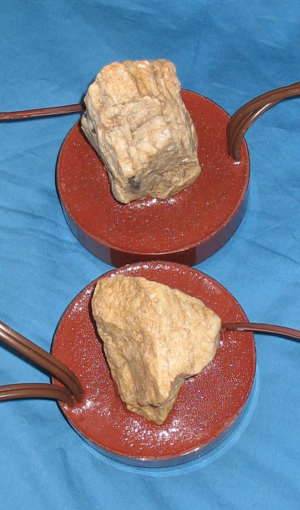
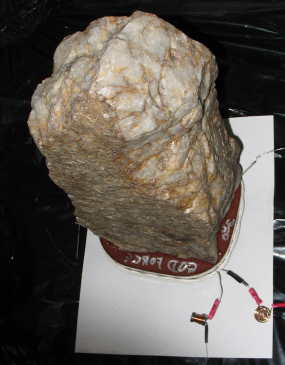 It's fairly self-explanatory, but I'll give you a tip or two.
It's fairly self-explanatory, but I'll give you a tip or two.
Unless I happen to be using a rock that has a bottom that sets the way I want it, I usually cast it in a smaller mold first. Especially the more phallic pieces. With rounder stones it is often easy to just prop the low end up with a smaller stone.
Here I have cast this huge one in a mold as small as can be found to accomodate it.
I make this first cast very metal-dense, with almost no non-metallic additives. Copper or brass shavings are highly recommended. Here I used both, then used a very iron-rich powder mix as well.
The nature of metal shavings allows them to be used to make a custom-fitted bed to rest the bottom of the rock on.
I try to set it as straight as possible, but one advantage of pre-casting it is that when I'm setting up to re-cast, I can easily shim up the original cast on any low sides. On this one I did pretty well the first time, but still had to use several layers of scrap hardware cloth to shim up one corner. In the past I have also used flat coils for shim. Both are great.
This piece has a companion stone, a funky danburite that I wrapped in wire, the end of which protrudes from the top of the cast for now. This is my output wire that you can make out on the left side of the pic below. This stone is set under a corner of the big one, where there was a gap to accommodate it.
The first thing I put in that mold was a section of hardware cloth (steel screen) that also had a wire worked into it that sticks out, too. This is my input wire, visible in the previous pic.
I also usually put a mobius coil in there. It can be under the stone in the first cast or the 2nd, or as in this case, wrapped around the first cast. Also I have a mobius strip here, of silver-coated copper tape.
I also put a hardware cloth in the outer cast. The 2nd input to this unit goes into a Loohan coil and some passive electronics to the mobius coil, then into more electronic components, then into this bottom hardware cloth.
This is a digression. You are probably not going to be able to do that OTB 30 stuff. I have another Loohan coil and more electronics on the output, and other electronic gizmos on the 1st input as well. I designed them to perform well when inputted with electronic amps, pre-amps or actual ultrasound signals as per OTB 28. Or of course non-electrified amps as in OTB 30.
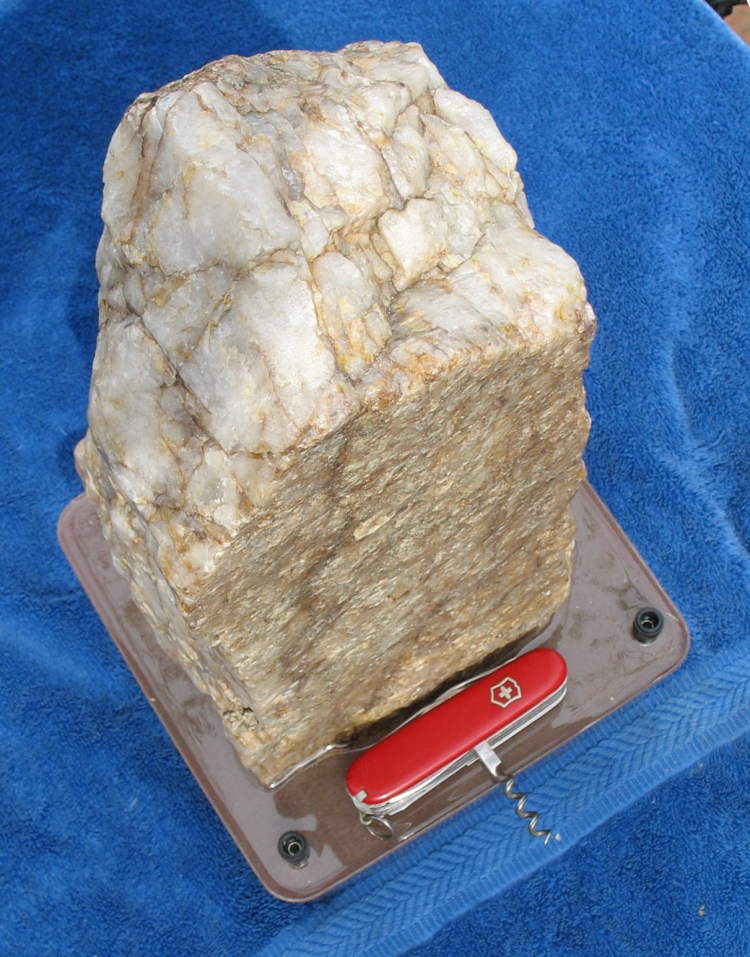 Given a large hunk of quartzite or other good stone, with some great programming, one can make a very powerful unit pretty cheaply.
Given a large hunk of quartzite or other good stone, with some great programming, one can make a very powerful unit pretty cheaply.
As it turned out, both this piece and the one at the top of the page weigh 28 lbs. each.
Note: due to mysterious reasons, this page may not display well in Firefox and some other browsers. IE works.

 Here is the bottom of the next project, and the screen in the 1st cast.
Here is the bottom of the next project, and the screen in the 1st cast.
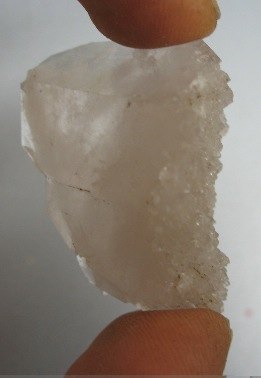 To prop up the low end in the first cast, I used this funky self-healed double-terminated quartz with the mantis program in it. And fluffy copper shavings
To prop up the low end in the first cast, I used this funky self-healed double-terminated quartz with the mantis program in it. And fluffy copper shavings
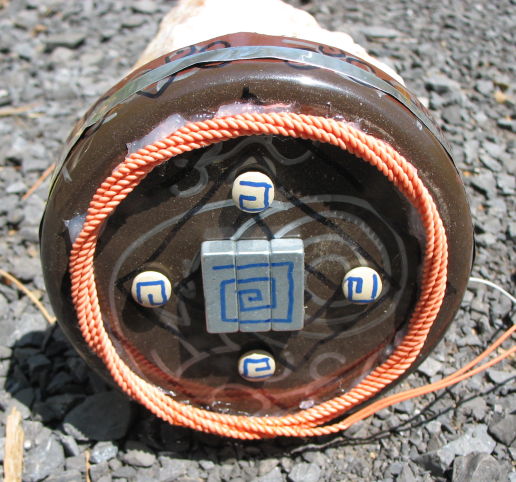 Every piece is different. In this one, I was fixin' to wrap the mobius around the 1st cast, when I realized it would be a lot better (on this particular piece) for the mobe to be under the cast. All other factors being equal, I would have preferred it around instead, to keep a lower profile and use less resin.
Every piece is different. In this one, I was fixin' to wrap the mobius around the 1st cast, when I realized it would be a lot better (on this particular piece) for the mobe to be under the cast. All other factors being equal, I would have preferred it around instead, to keep a lower profile and use less resin.
I dowsed the best diameter of the coil.
I used no electronic components other than an RCA-style jack, as I don't think they would have improved this particular unit. I did add the mobius strip. In the center bottom, I used 3 strong bar magnets together to make a square, and 4 tablets of triphala herb. Placed for maximum resonance.
I glued all these things in place with silicone or krazy glue, depending. The magnets didn't need much help, due to the iron-rich mix I'd used.
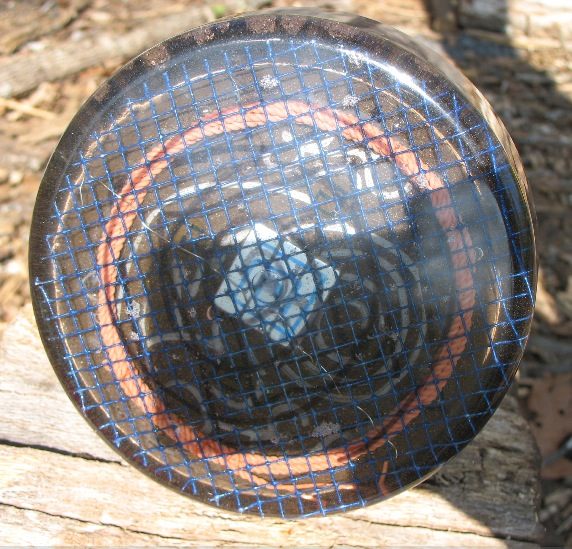 Then I also tack-glued a round section of hardware cloth to the bottom of all this, and set it in the mold. The mold already contained a hardened layer of clearcast, and atop that, fresh epoxy. I did not need to shim anything, as by some fluke it all set straight. It was slightly eccentric, though (aren't we all), so I had to place it a bit off-center in the mold.
Then I also tack-glued a round section of hardware cloth to the bottom of all this, and set it in the mold. The mold already contained a hardened layer of clearcast, and atop that, fresh epoxy. I did not need to shim anything, as by some fluke it all set straight. It was slightly eccentric, though (aren't we all), so I had to place it a bit off-center in the mold.
This is the finished base.
Incidentally, I always spray my hardware cloth with cobalt blue paint (Rustoleum # 7251 metallic) for slightly improved energy and looks.
Note how the hardware cloth is at 45 degrees to the magnet block. Details, details.
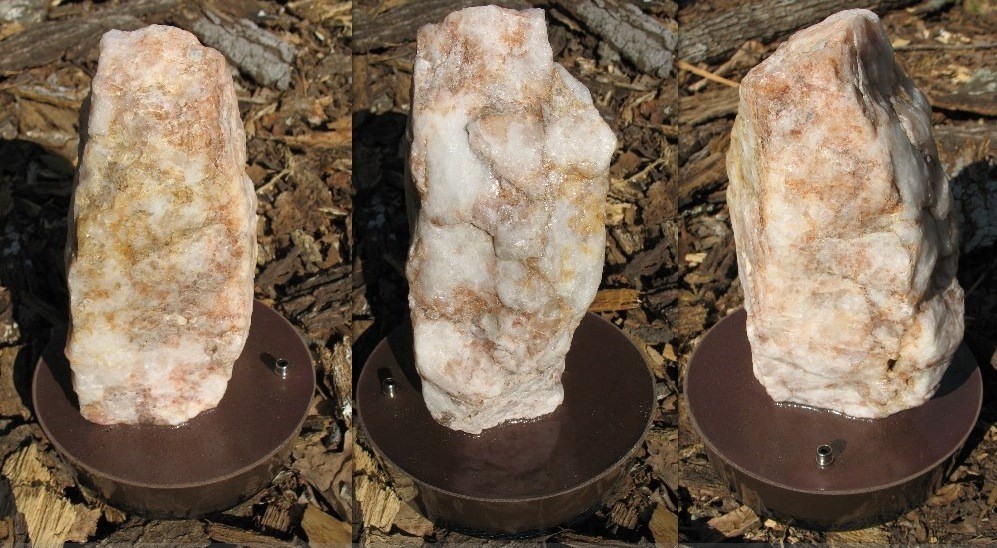 .
.
An RCA jack is a 2-wire connector that is a lot more durable than a chassis jack. I would not cast anything so flimsy as the latter into resin.
However, one cannot run a circuit through this unit, as 1 of the connections grounds into the top screen (in the first cast), and the other goes through the mobius and grounds into the bottom screen. So the unit accepts 2 uniwire connections.
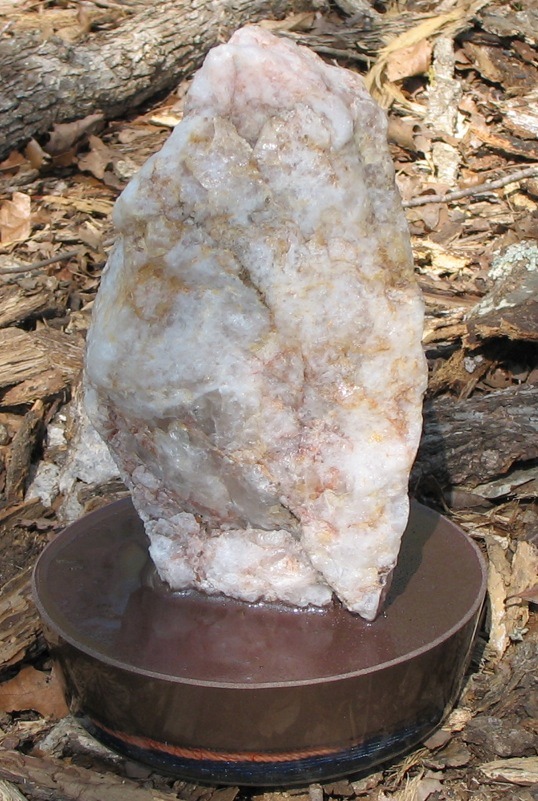
The unit to the left has a nice "shelf" that is perfectly functional as a witness plate. One could place more programmed stones on it.
The reasons this unit is so powerful are great programming, great materials, and appropriate design for this unit. I build the unit in front of me, rather than going on some rote formula. I avoid unnecessary complexity, only adding stuff where it actually improves the power. Unlike some of the things I made years ago that you can see on this site.
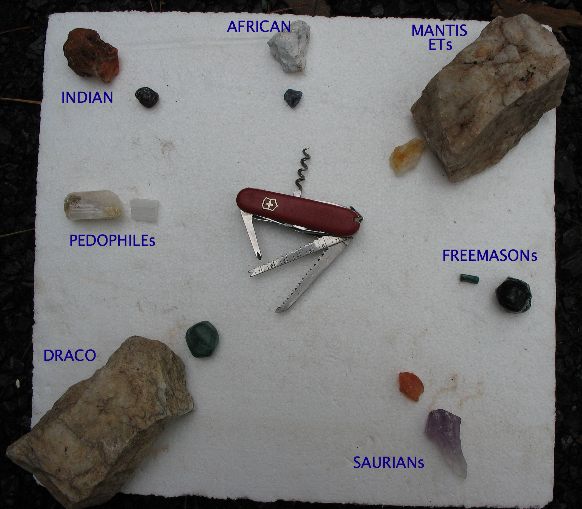 Moving right along. It's May 8, and I just de-molded something a bit different.
Moving right along. It's May 8, and I just de-molded something a bit different.
I needed something powerful against the mantises specifically. For the center stone, we switched the programs from the anti-Draco and the anti-mantis crystals of OTB 27, and I used the former Draco one. One can only have one of the Mantis sets, but any number of the secondary program that includes a jailed mantis. The big stone can only have one of these latter, as each stone only holds one entity, even if the stone is much bigger.
For more power, I needed to incorporate some more of the latter into a piece with the big stone.
After some brainstorming, the most potent configuration I could think of was the good old Trinity Wand formation.
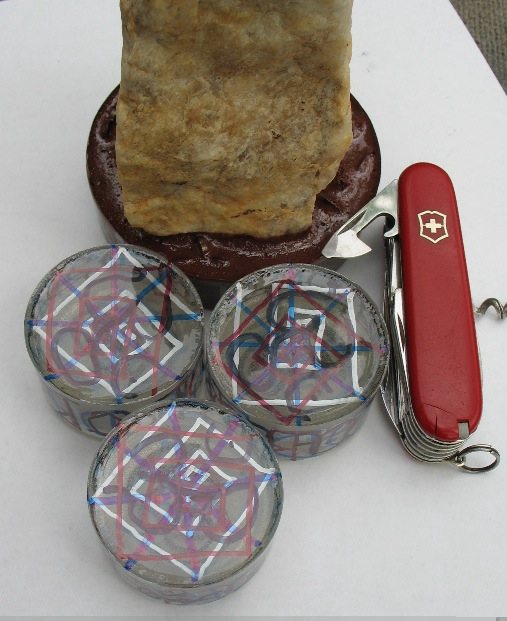 I pre-cast the stone into an iron-rich mix with a piece of hardware cloth. I did not use brass or copper here, only steel shavings. Every piece is different. I also cast 3 clear disks of the optimum diameter and just high enough to contain the strongest mantises that were available from my jail. These disks did not all come out exactly the same height, but that's OK. I would later use the height differences in lieu of shim to align the stone vertically.
I pre-cast the stone into an iron-rich mix with a piece of hardware cloth. I did not use brass or copper here, only steel shavings. Every piece is different. I also cast 3 clear disks of the optimum diameter and just high enough to contain the strongest mantises that were available from my jail. These disks did not all come out exactly the same height, but that's OK. I would later use the height differences in lieu of shim to align the stone vertically.
Also (not shown) I put a mobius strip around the pre-cast.
This unit has only 1 coil (mobius), 1 screen, and 1 mobius strip.
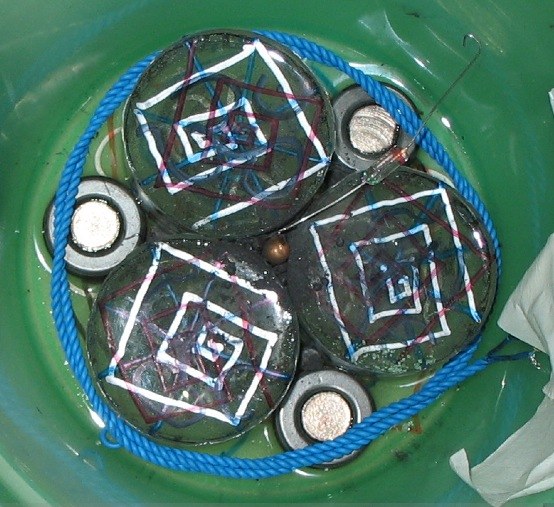 I had also cast a thin clear layer in the bottom of this mold. Then on top of that, I pre-glued with thin epoxy (stuff slips around on thick epoxy) the 3 disks as well as 3 ferrite toroids containing bismuth disks. After curing, Pitwexin would program these latter with the anti-evil and anti-chemtrail programs. For the most part, the entire base has Arcturan programming, but some components have 2-part programs and the disks just have the jailed entity program.
I had also cast a thin clear layer in the bottom of this mold. Then on top of that, I pre-glued with thin epoxy (stuff slips around on thick epoxy) the 3 disks as well as 3 ferrite toroids containing bismuth disks. After curing, Pitwexin would program these latter with the anti-evil and anti-chemtrail programs. For the most part, the entire base has Arcturan programming, but some components have 2-part programs and the disks just have the jailed entity program.
After this had set up fairly well, I slipped on the mobius coil. I also stuffed intense items into the crevice in the center, including magnetite, a dynamic mic element, and and infrared emitter wired to the germanium diode as well as a copper bead. A dab of antimony.
I hooked up several more passive electronic components, for linking the screen and the mobius wires.
I stuck a magnetite pebble in each of the 3 other crevices, and placed a tumbled amethyst on each bismuth slug. More items for P to program with anti-CT and anti-evil. Then I poured my mix over it all, then set the pre-cast on top, aligning it vertically.
After several more pours, it was done, with a binding post sticking out.
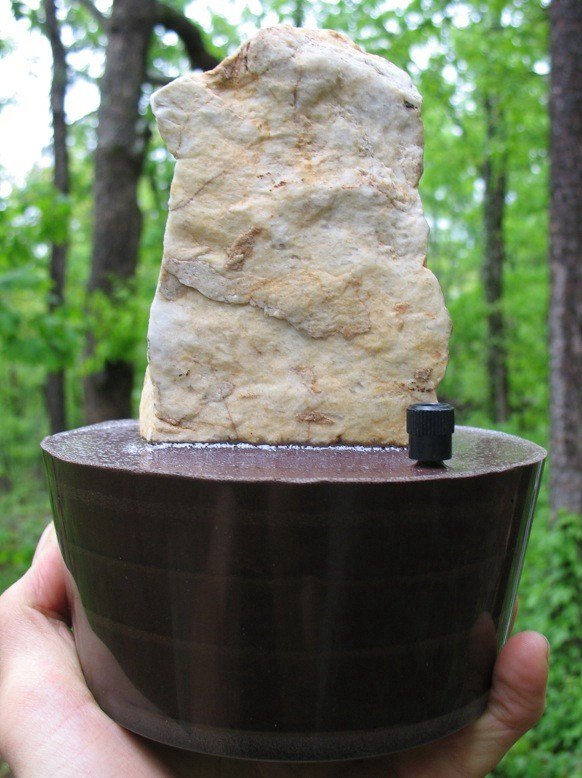 Ta-da! It came out incredibly intense. I doubt it would benefit much from having anything piped into it, but the post should output some great stuff that would not need further amplification.
Ta-da! It came out incredibly intense. I doubt it would benefit much from having anything piped into it, but the post should output some great stuff that would not need further amplification.
It responds extremely well to being physically held and worked with.
I call it the Mantis Tombstone.
Got mantis problems? Email me and I'll send the bugs a little jolt.
The companion stone program (for the quartzite) was transferred into a smaller, natural citrine which I can carry in my left sock.
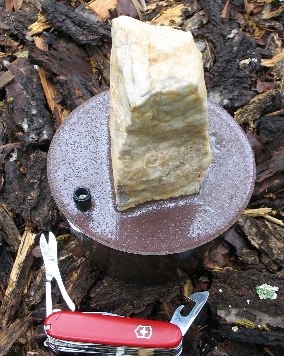
May 7, '08:
Warning! It turns out that the mantises are able to corrupt units that have quartz protruding from the resin. I had to have Pitwexin fix my Tombstone 3 times, then I cast a cap onto it, which stopped this tomfoolery.
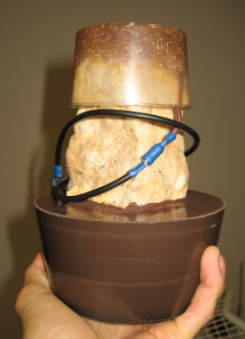 This was all that was necessary. But then I decided to do more.
This was all that was necessary. But then I decided to do more.
I doubt that this is a problem normally; the mantises had to be very motivated to cripple this particular weapon. I don't think other species can do this, and the mantises seem to be being eradicated. If you think this may have happened to you, you can call on Pitwexin or email me.
Loohan
next OTB
It's fairly self-explanatory, but I'll give you a tip or two.
Given a large hunk of quartzite or other good stone, with some great programming, one can make a very powerful unit pretty cheaply.
Here is the bottom of the next project, and the screen in the 1st cast.
To prop up the low end in the first cast, I used this funky self-healed double-terminated quartz with the mantis program in it. And fluffy copper shavings
Every piece is different. In this one, I was fixin' to wrap the mobius around the 1st cast, when I realized it would be a lot better (on this particular piece) for the mobe to be under the cast. All other factors being equal, I would have preferred it around instead, to keep a lower profile and use less resin.
Then I also tack-glued a round section of hardware cloth to the bottom of all this, and set it in the mold. The mold already contained a hardened layer of clearcast, and atop that, fresh epoxy. I did not need to shim anything, as by some fluke it all set straight. It was slightly eccentric, though (aren't we all), so I had to place it a bit off-center in the mold.
Moving right along. It's May 8, and I just de-molded something a bit different.
I pre-cast the stone into an iron-rich mix with a piece of hardware cloth. I did not use brass or copper here, only steel shavings. Every piece is different. I also cast 3 clear disks of the optimum diameter and just high enough to contain the strongest mantises that were available from my jail. These disks did not all come out exactly the same height, but that's OK. I would later use the height differences in lieu of shim to align the stone vertically.
I had also cast a thin clear layer in the bottom of this mold. Then on top of that, I pre-glued with thin epoxy (stuff slips around on thick epoxy) the 3 disks as well as 3 ferrite toroids containing bismuth disks. After curing, Pitwexin would program these latter with the anti-evil and anti-chemtrail programs. For the most part, the entire base has Arcturan programming, but some components have 2-part programs and the disks just have the jailed entity program.
Ta-da! It came out incredibly intense. I doubt it would benefit much from having anything piped into it, but the post should output some great stuff that would not need further amplification.
This was all that was necessary. But then I decided to do more.
 home coil info products ordering
home coil info products ordering






